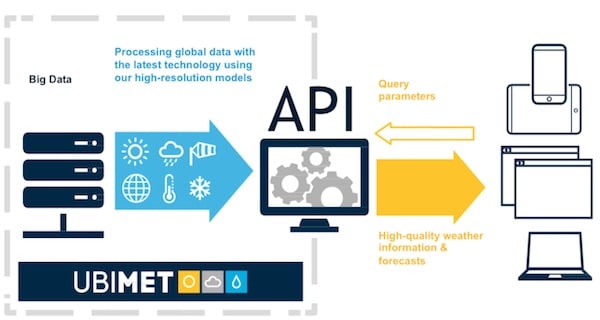Reanalysis
Knowledge of historical weather data is becoming increasingly important. This information is highly relevant, in particular for the insurance industry and in location planning. This applies, for example, in determining the probability of hail storms in a certain region or in identifying the most suitable locations for sun or wind energy plants under climatic aspects.
How does reanalysis work?
In order to find out what the weather conditions were like at any given coordinate at any given time, even at locations without meteorological observations, the UBIMET research team developed a special analytical method. This enables the interpolation of measured values undertaking into consideration topography, land cover as well as radar and satellite data to a grid with a horizontal resolution of down to 100m.
Depending on the measuring frequency of the weather data, it is possible to generate the analysis for parameters such as temperature, precipitation or wind with a temporal resolution of down to ten minutes. The actual resolution that can be achieved depends on the local data availability; information available upon request. In addition to original reanalysis, it is also possible, upon individual request, to generate statistical evaluations such as mean values, extreme values or the frequency of exceeded threshold values. Reanalysis and the deduced values calculated on their basis can be provided in the form of a grid (Geotiff, Gribfile) or, for selected coordinates, in the form of time series in Excel or Text files. If required, we gladly prepare graphics of the reanalysis or their evaluation.
Our portfolio comprises the following past meteorological parameters:
- Historical temperature data: dry temperature, temperature, perceived temperature
- Historical humidity data: dew point, relative humidity, specific humidity
- Historical air pressure data (reduced to sea level or at ground level)
- Historical wind data: wind speed, wind gusts and wind direction
- Historical precipitation data: total precipitation, precipitation type
- Historical snow data: fresh snow depth, total snow depth
- Past weather conditions including cloud cover, duration of sunshine and solar radiation
- Unique historical parameters such as Lightning density and likelihood of hail with a diameter of at least 0.5, 1, 2, 3 and 4 cm
Weather reanalysis in action:
Infrastructure & Transportation
UBIMET’s reanalysis package, based on historical weather data, assists with the process of defining areas where construction of new infrastructure would not be recommended, or where special risk management measures should be carried out. Reanalysis is highly relevant for planning new roads, railways or determining the ideal location for new infrastructure. With reanalysis, it is possible to identify areas of high weather activity (e.g. snowfall) and to integrate solutions into infrastructure design to mitigate impact (e.g. snow fences/snow etc.).
Insurance
To manage risk exposure within the insurance industry, it is important to know the existing risk probability as precisely as possible and to calculate premiums based on this. With UBIMET’s historical reanalysis package, it is possible to analyze damage-related parameters such as hail, storm or lightning, and identify regions of increased risk.
Energy
In the renewable energy sector (wind farms, hydropower dams and solar power plants) the perfect placement of assets is essential. UBIMET’s reanalysis package assists in finding suitable locations during the planning phase, thus optimising energy yield and operational efficiency.
Retail
Reanalysis is also relevant in the retail sector. The connection between the weather and the products sold is often not immediately apparent. UBIMET analyses sales figures and historical weather data and develops correlations between weather events and a wide range of products. With correlations, predictions for future sales figures are possible; inventory stock can be ordered and advertising optimized accordingly.
Looking for a weather API?
With the UBIMET API “UBI:Connect” it’s easy to create a connection between your systems and UBIMET’s high-quality hyper-local weather database. Find out more on our dedicated weather API page or ask for more information below.












